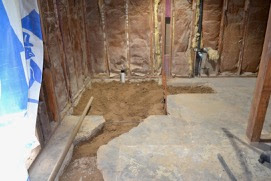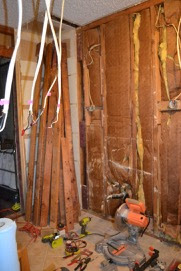We've been working all day, almost every day on this bathroom. There really is a tremendous amount of work to be done, but it seems we didn't accomplish much this week. That's what happens when you have to depend on someone else hired to do a job. He hired a plumber for part of the work, so we are now at his mercy.
At the end of last week, we finished removing the tile and the thinset and mastic adhesives.
We took at chance on this adhesive stripper and it actually worked. I mean, it was still hard work, but it softened both kinds of adhesive and made it marginally easier to scrape off.
So, that's done.
Since the plumbers were going to saw out and break up concrete and we didn't want them tromping through our bedroom with chunks of concrete, we went ahead and made the hole in the wall for the new door, which hasn't arrived yet.
We consulted with a brick mason before we did this. He made it sound like the bricks would come out easily, but that really wasn't the case. Husband used a special saw blade to cut the mortar below the top row of bricks. Then he used his compressor hammer to chip away the mortar to get the first few bricks out. After he had a few out and I could carve out a little workspace of my own, I used the same hammer and chisel that I used on the tile to pry the brick loose from the mortar.
In my opinion, using hand tools for this job is far more effective than power tools. I cleaned off each brick as we went and stacked them neatly for the brickmason to use when he repairs the area after we get the door in. This took about six hours to accomplish. It is possible for a woman to do it (because I removed a lot of the brick working by myself), but, believe me, a man can do it much quicker than a woman. It takes physical strength. And, let's face it, men are stronger than women. Period.
Of course, it's been 80 degrees here, but as soon as we got a big gaping hole in the side of our house, a cold front blew in, with rain, and it was 31 degrees last night. Husband had to scramble to cover the hole so we wouldn't die of exposure.
This is what the plumbers accomplished the first two days (Wednesday and Thursday) on the job. They sawed a square in the concrete foundation, then broke it up with a jackhammer. Plus, they took out the tub plumbing, moving the vent, the copper water lines, and the drain to their new locations for the shower. They didn't come at all on Friday for some undetermined reason.
Hopefully, they will show up on Monday to complete the job either Monday or Tuesday.
Then, the FUN begins. And, that is putting the bathroom back together - shower, tile, shiplap, vanities, lights...
YIPPEE!
Go here for part four.












































